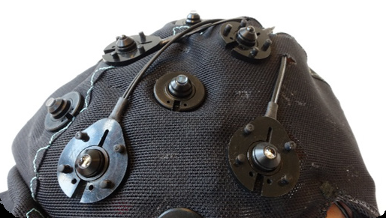Short-Distance Detectors
NIRx has developed a cutting edge method of capturing the superficial confounding signals (i.e. scalp perfusion, respiration, meyer waves, cardiac). One of the fundamental challenges in fNIRS is the isolation of cortical functional activation from these signals of non-interest. As the field of fNIRS has matured, the importance of employment, and efficacy in use, of multi-distance placements for identification and potential for removal of such components, has been demonstrated.
…With NIRx
Our engineered solution allows for full scalp placement
We provide literature supported 8mm short distance channels.
Multiple bundles for scalability
Short Channel Advantages…
Improved analysis
Greater characterization global systemic artifacts
Quality assurance in (data) collection
Tachtsidis and Scholkmann “False positives and false negatives in functional near-infrared spectroscopy: issues, challenges and the way forward.” Neurophotonics 3.3(2016):031405.
Functionality
Long channel (in yellow) between a source and detector and short-channel (in purple) detected by short channels clipped under the source.
True short-distance source-detector-separation:
Default = 8 mm, other distances possible
Compatible with all NIRx instruments
(NIRScout, NIRScoutXP, NIRSport1, NIRSport2)
Highly economic:
8 short-distance channels occupy one detector channel
Supported by NIRx Software:
NIRStar, nirsLAB, Aurora, NIRSite
Easy-to apply and comfortable for subjects
Applicable on all head areas, with and without hair
Each short-distance detector bundle is effectively driven by just one single detecting probe, providing a total of eight independent short-distance channels; which can be freely placed over the cortex to capture global artifact(s). Multiple bundles may be employed to provide for high resolution cortical coverage, spanning any number of channels. These can be seen below straddling each emitting source.
Short channel bundle with single-tip optodes.
Short channel bundle around holder bases
+ Selected Publications
Santosa, H., Zhai, X., Fishburn, F., Sparto, P. J., & Huppert, T. J. (2020). Quantitative comparison of correction techniques for removing systemic physiological signal in functional near-infrared spectroscopy studies. Neurophotonics, 7(3), 035009.
Wyser, D., Mattille, M., Wolf, M., Lambercy, O., Scholkmann, F., & Gassert, R. (2020). Short-channel regression in functional near-infrared spectroscopy is more effective when considering heterogeneous scalp hemodynamics. Neurophotonics, 7(3), 035011.
Caldwell, M., Scholkmann, F., Wolf, U., Wolf, M., Elwell, C., & Tachtsidis, I. (2016). Modelling confounding effects from extracerebral contamination and systemic factors on functional near-infrared spectroscopy. Neuroimage, 143, 91-105.






